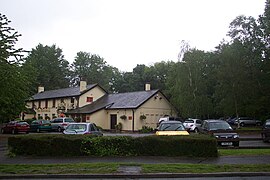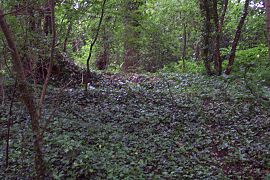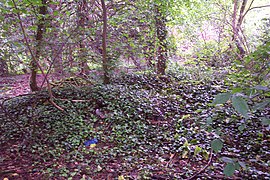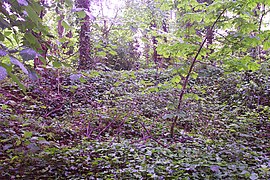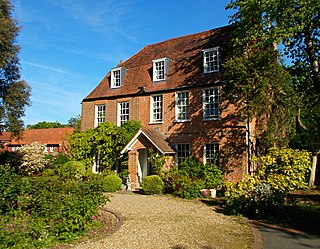
Cheam is a suburb of London, England, 10.9 miles (17.5 km) southwest of Charing Cross. It is divided into North Cheam, Cheam Village and South Cheam. Cheam Village contains the listed buildings Lumley Chapel and the 16th-century Whitehall. It is adjacent to two large parks, Nonsuch Park and Cheam Park. Nonsuch Park contains the listed Nonsuch Mansion. Parts of Cheam Park and Cheam Village are in a conservation area. Cheam is bordered by Worcester Park to the northwest, Morden to the northeast, Sutton to the east, Epsom, Ewell and Stoneleigh to the west and Banstead and Belmont to the south.

Abbey Park is a public park in Leicester, England, through which the River Soar flows. It is owned and managed by Leicester City Council. It opened in 1882 on the flood plain of the River Soar, and expanded in 1932 to include the area west of the river that had formerly been the medieval St Mary's Abbey, still bounded by large medieval walls. The park includes the archaeological sites of the Abbey and the ruins of Cavendish House, along with a wide range of decorative and recreational parkland features.

Epsom and Ewell is a local government district with borough status in Surrey, England, covering the towns of Epsom and Ewell. The borough lies just outside the administrative boundary of Greater London, but it is entirely within the M25 motorway which encircles London. Many of the borough's urban areas form part of the wider Greater London Built-up Area.
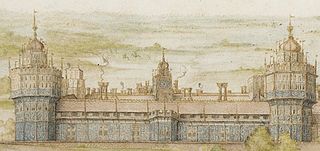
Nonsuch Palace was a Tudor royal palace, commissioned by Henry VIII in Surrey, England and completed in 1538. Its site lies in what is now Nonsuch Park on the boundaries of the borough of Epsom and Ewell in Surrey and the London Borough of Sutton.

The Hogsmill River in Surrey and Greater London, England is a small chalk stream tributary of the River Thames. It rises in Ewell and flows into the Thames at Kingston upon Thames on the lowest non-tidal reach, that above Teddington Lock.

Witley Court, in Great Witley, Worcestershire, England, is a ruined Italianate mansion. Built for the Foleys in the seventeenth century on the site of a former manor house, it was enormously expanded in the early nineteenth century by the architect John Nash for Thomas Foley, 3rd Baron Foley. The estate was later sold to the Earls of Dudley, who undertook a second massive reconstruction in the mid-19th century, employing the architect Samuel Daukes to create one of the great palaces of Victorian and Edwardian England.

Whiteknights Park, or the Whiteknights Campus of the University of Reading, is the principal campus of that university. The park covers the area of the manor of Earley Whiteknights, also known as Earley St Nicholas and Earley Regis.

Ewell is a town in the Borough of Epsom and Ewell in Surrey, England. It is approximately 12 miles (19 km) south of central London and 2 miles (3.2 km) northeast of Epsom. In the 2011 Census, the town had a population of 34,872. The majority of which (73%) is in the ABC1 social class, except the Ruxley Ward that is C2DE.

Worcester Park is a suburban town in South West London, England. It lies in the London boroughs of Sutton and Kingston, and partly in the Surrey borough of Epsom and Ewell. The area is 10 miles (16 km) southwest of Charing Cross. The suburb's population was 16,031 at the time of the 2001 census. The suburb comprises the Worcester Park ward, an electoral area of the London Borough of Sutton with a population in 2011 of 11,655, as well as the Cuddington ward, an electoral area of Epsom and Ewell, which had a population of 5,791 at the time of the 2001 census.

Grafton is a suburb of Auckland, New Zealand. The suburb is named for the Duke of Grafton, a patron of the first Governor of New Zealand, William Hobson, and the grandfather of a subsequent Governor, Robert FitzRoy. Once known as 'Grafton Heights', denoting its history as a well-off suburb in Auckland's earliest decades.
Stoneleigh is a village in the Epsom and Ewell borough in the county of Surrey, England. It is situated approximately 11 miles (18 km) from central London. In the 2011 Census, the population was 8,741.

Nonsuch Park is a public park between Stoneleigh, Cheam, and Ewell in the borough of Epsom and Ewell in Surrey, England. It borders the London Borough of Sutton. It is the last surviving part of the Little Park of Nonsuch, a deer hunting park established by Henry VIII surrounding the former Nonsuch Palace.
Old Malden is a ward of the Royal Borough of Kingston upon Thames in south London, 10 miles (16 km) south west of Charing Cross. It is between New Malden and Worcester Park, along the A4023 road, here named Malden Road.
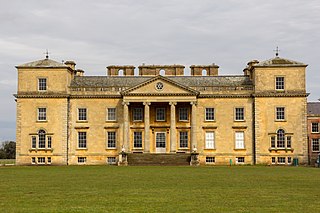
Croome Court is a mid-18th-century Neo-Palladian mansion surrounded by extensive landscaped parkland at Croome D'Abitot, near Upton-upon-Severn in south Worcestershire, England. The mansion and park were designed by Lancelot "Capability" Brown for the 6th Earl of Coventry, and they were Brown's first landscape design and first major architectural project. Some of the mansion's rooms were designed by Robert Adam. St Mary Magdalene's Church, Croome D'Abitot that sits within the grounds of the park is now owned and cared for by the Churches Conservation Trust.
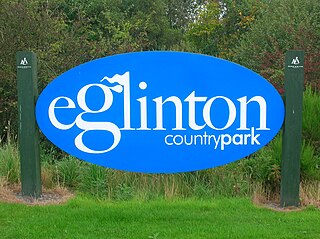
Eglinton Country Park is located on the grounds of the old Eglinton Castle estate in Kilwinning, North Ayrshire, Scotland. Eglinton Park is situated in the parish of Kilwinning, part of the former district of Cunninghame, and covers an area of 400 ha ([98 acres ] of which are woodland. The central iconic feature of the country park is the ruined Eglinton Castle, once home to the Eglinton family and later the Montgomeries, Earls of Eglinton and chiefs of the Clan Montgomery. Eglinton Country Park is managed and maintained by North Ayrshire Council and its Ranger Service.

Barboursville is the ruin of the mansion of James Barbour, located in Barboursville, Virginia. He was the former U.S. Senator, U.S. Secretary of War, and Virginia Governor. It is now within the property of Barboursville Vineyards. The house was designed by Thomas Jefferson, president of the United States and Barbour's friend and political ally. The ruin is listed on the National Register of Historic Places.
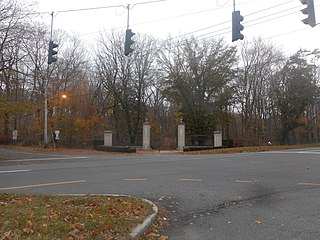
The Knollwood estate was a Gold Coast era castle-esque house and estate. Located in Muttontown, New York, U.S., its ruins are now part of the Muttontown Preserve.

The New Garden in Potsdam is a park of 102.5 hectares located southwest of Berlin, Germany, in northern Potsdam and bordering on the lakes Heiliger See and Jungfernsee. Starting in 1787, Frederick William II of Prussia (1744-1797) arranged to have a new garden laid out on this site, and the design and landscaping was carried out by Johann August Eyserbeck, who had previously worked on the Dessau-Wörlitz Garden Realm.
Wimbledon manor house; the residence of the lord of the manor, was an English country house at Wimbledon, Surrey, now part of Greater London. The manor house was over the centuries exploded, burnt and several times demolished. The first known manor house, The Old Rectory was built around 1500 still stands as a private home, despite very nearly falling into a state beyond repair, in the 19th century. The ambitious later Elizabethan prodigy house, Wimbledon Palace, was "a house of the first importance" according to Sir John Summerson, and is now demolished.
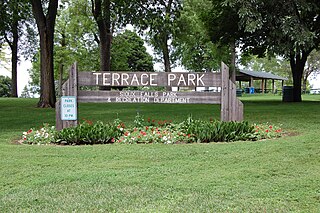
Terrace Park, historically known as Covell Lake Park or Phillips Park, is a 52-acre (21 ha) public park on the shores of Covell Lake in Sioux Falls, South Dakota. Founded in 1916, its modern name is derived from its steep terraces. It was listed on the National Register of Historic Places as Terrace Park and Japanese Gardens in 2015.


